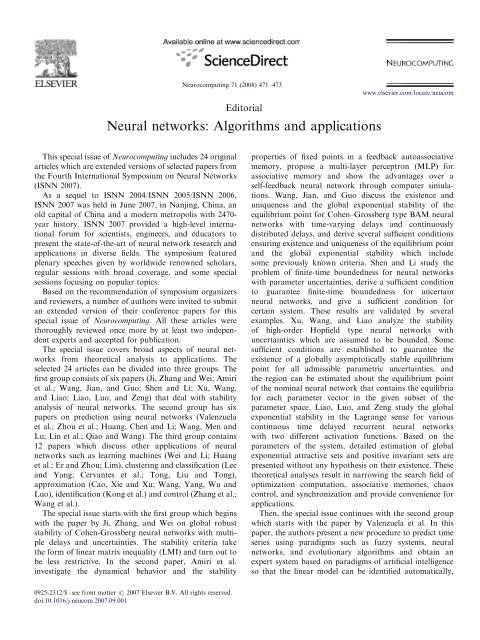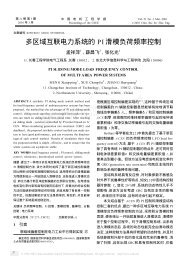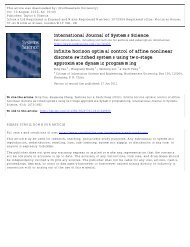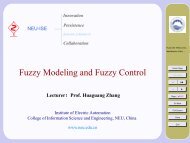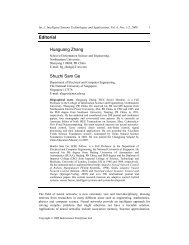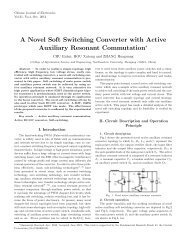Neural networks: Algorithms and applications
Neural networks: Algorithms and applications
Neural networks: Algorithms and applications
You also want an ePaper? Increase the reach of your titles
YUMPU automatically turns print PDFs into web optimized ePapers that Google loves.
ARTICLE IN PRESS<br />
Neurocomputing 71 (2008) 471–473<br />
www.elsevier.com/locate/neucom<br />
Editorial<br />
<strong>Neural</strong> <strong>networks</strong>: <strong>Algorithms</strong> <strong>and</strong> <strong>applications</strong><br />
This special issue of Neurocomputing includes 24 original<br />
articles which are extended versions of selected papers from<br />
the Fourth International Symposium on <strong>Neural</strong> Networks<br />
(ISNN 2007).<br />
As a sequel to ISNN 2004/ISNN 2005/ISNN 2006,<br />
ISNN 2007 was held in June 2007, in Nanjing, China, an<br />
old capital of China <strong>and</strong> a modern metropolis with 2470-<br />
year history. ISNN 2007 provided a high-level international<br />
forum for scientists, engineers, <strong>and</strong> educators to<br />
present the state-of-the-art of neural network research <strong>and</strong><br />
<strong>applications</strong> in diverse fields. The symposium featured<br />
plenary speeches given by worldwide renowned scholars,<br />
regular sessions with broad coverage, <strong>and</strong> some special<br />
sessions focusing on popular topics.<br />
Based on the recommendation of symposium organizers<br />
<strong>and</strong> reviewers, a number of authors were invited to submit<br />
an extended version of their conference papers for this<br />
special issue of Neurocomputing. All these articles were<br />
thoroughly reviewed once more by at least two independent<br />
experts <strong>and</strong> accepted for publication.<br />
The special issue covers broad aspects of neural <strong>networks</strong><br />
from theoretical analysis to <strong>applications</strong>. The<br />
selected 24 articles can be divided into three groups. The<br />
first group consists of six papers (Ji, Zhang <strong>and</strong> Wei; Amiri<br />
et al.; Wang, Jian, <strong>and</strong> Guo; Shen <strong>and</strong> Li; Xu, Wang,<br />
<strong>and</strong> Liao; Liao, Luo, <strong>and</strong> Zeng) that deal with stability<br />
analysis of neural <strong>networks</strong>. The second group has six<br />
papers on prediction using neural <strong>networks</strong> (Valenzuela<br />
et al.; Zhou et al.; Huang, Chen <strong>and</strong> Li; Wang, Men <strong>and</strong><br />
Lu; Lin et al.; Qiao <strong>and</strong> Wang). The third group contains<br />
12 papers which discuss other <strong>applications</strong> of neural<br />
<strong>networks</strong> such as learning machines (Wei <strong>and</strong> Li; Huang<br />
et al.; Er <strong>and</strong> Zhou; Lim), clustering <strong>and</strong> classification (Lee<br />
<strong>and</strong> Yang; Cervantes et al.; Tong, Liu <strong>and</strong> Tong),<br />
approximation (Cao, Xie <strong>and</strong> Xu; Wang, Yang, Wu <strong>and</strong><br />
Luo), identification (Kong et al.) <strong>and</strong> control (Zhang et al.;<br />
Wang et al.).<br />
The special issue starts with the first group which begins<br />
with the paper by Ji, Zhang, <strong>and</strong> Wei on global robust<br />
stability of Cohen-Grossberg neural <strong>networks</strong> with multiple<br />
delays <strong>and</strong> uncertainties. The stability criteria take<br />
the form of linear matrix inequality (LMI) <strong>and</strong> turn out to<br />
be less restrictive. In the second paper, Amiri et al.<br />
investigate the dynamical behavior <strong>and</strong> the stability<br />
properties of fixed points in a feedback autoassociative<br />
memory, propose a multi-layer perceptron (MLP) for<br />
associative memory <strong>and</strong> show the advantages over a<br />
self-feedback neural network through computer simulations.<br />
Wang, Jian, <strong>and</strong> Guo discuss the existence <strong>and</strong><br />
uniqueness <strong>and</strong> the global exponential stability of the<br />
equilibrium point for Cohen–Grossberg type BAM neural<br />
<strong>networks</strong> with time-varying delays <strong>and</strong> continuously<br />
distributed delays, <strong>and</strong> derive several sufficient conditions<br />
ensuring existence <strong>and</strong> uniqueness of the equilibrium point<br />
<strong>and</strong> the global exponential stability which include<br />
some previously known criteria. Shen <strong>and</strong> Li study the<br />
problem of finite-time boundedness for neural <strong>networks</strong><br />
with parameter uncertainties, derive a sufficient condition<br />
to guarantee finite-time boundedness for uncertain<br />
neural <strong>networks</strong>, <strong>and</strong> give a sufficient condition for<br />
certain system. These results are validated by several<br />
examples. Xu, Wang, <strong>and</strong> Liao analyze the stability<br />
of high-order Hopfield type neural <strong>networks</strong> with<br />
uncertainties which are assumed to be bounded. Some<br />
sufficient conditions are established to guarantee the<br />
existence of a globally asymptotically stable equilibrium<br />
point for all admissible parametric uncertainties, <strong>and</strong><br />
the region can be estimated about the equilibrium point<br />
of the nominal neural network that contains the equilibria<br />
for each parameter vector in the given subset of the<br />
parameter space. Liao, Luo, <strong>and</strong> Zeng study the global<br />
exponential stability in the Lagrange sense for various<br />
continuous time delayed recurrent neural <strong>networks</strong><br />
with two different activation functions. Based on the<br />
parameters of the system, detailed estimation of global<br />
exponential attractive sets <strong>and</strong> positive invariant sets are<br />
presented without any hypothesis on their existence. These<br />
theoretical analyses result in narrowing the search field of<br />
optimization computation, associative memories, chaos<br />
control, <strong>and</strong> synchronization <strong>and</strong> provide convenience for<br />
<strong>applications</strong>.<br />
Then, the special issue continues with the second group<br />
which starts with the paper by Valenzuela et al. In this<br />
paper, the authors present a new procedure to predict time<br />
series using paradigms such as fuzzy systems, neural<br />
<strong>networks</strong>, <strong>and</strong> evolutionary algorithms <strong>and</strong> obtain an<br />
expert system based on paradigms of artificial intelligence<br />
so that the linear model can be identified automatically,<br />
0925-2312/$ - see front matter r 2007 Elsevier B.V. All rights reserved.<br />
doi:10.1016/j.neucom.2007.09.001
472<br />
ARTICLE IN PRESS<br />
Editorial / Neurocomputing 71 (2008) 471–473<br />
without the need for human expert participation. Zhou<br />
et al. propose a novel method for recognizing gene in<br />
genomes which combines three famous gene-finding<br />
programs. Simulation results indicate that the proposed<br />
method has a powerful capability for gene prediction.<br />
Huang, Chen, <strong>and</strong> Li develop the neural network-based<br />
surface roughness Pokayoke (NN-SRPo) system to keep<br />
the surface roughness within a desired value in an inprocess<br />
manner. Both the surface roughness prediction <strong>and</strong><br />
machining parameters control are performed online during<br />
the machining process. A testing experiment demonstrates<br />
the efficacy of this NN-SRPo system. Wang, Men, <strong>and</strong> Lu<br />
develop an online SVM model to predict air pollutant<br />
levels using time series based on the monitored air<br />
pollutant database in Hong Kong downtown area. The<br />
experiment comparison between the online SVM model<br />
<strong>and</strong> the conventional SVM model (non-online SVM model)<br />
demonstrates the effectiveness <strong>and</strong> efficiency in predicting<br />
air quality parameters with different time series. Lin<br />
et al. forecast power loads using an adaptive self-tuning<br />
approach. The predictor uses the current state of power<br />
loads as its input <strong>and</strong> the next state of power loads can be<br />
forecasted precisely. Validation results using practical data<br />
indicate that this method is effective. Qiao <strong>and</strong> Wang<br />
propose a new learning algorithm for creating selforganizing<br />
fuzzy neural <strong>networks</strong> (SOFNN) to solve the<br />
problem of conventional input–output space partitioning.<br />
Simulation studies demonstrate that the present algorithm<br />
is superior in terms of compact structure <strong>and</strong> learning<br />
efficiency compared with other approaches.<br />
Next, the special issue includes the third group which<br />
starts with the paper by Wei <strong>and</strong> Li. In their paper, a novel<br />
optimum extreme learning machines (ELM) construction<br />
method is developed. The performance of the proposed<br />
method through UCI benchmark datasets is investigated.<br />
Huang et al. extend previously proposed incremental<br />
extreme learning machine (I-EML) from real domain to<br />
complex domain. It is shown that as long as the hidden<br />
layer activation function is complex continuous discriminatory<br />
or complex bounded nonlinear piecewise continuous,<br />
I-ELM can still approximate any target functions in<br />
the complex domain. The universal capability of the<br />
I-ELM in complex domain is further verified by two<br />
function approximation problems <strong>and</strong> one channel equalization<br />
problem. Er <strong>and</strong> Zhou present a novel framework<br />
for automatic generation of fuzzy neural <strong>networks</strong> (FNNs)<br />
termed hierarchically generated fuzzy neural <strong>networks</strong><br />
(HGFNN) for realizing machine intelligence. Simulation<br />
studies on mobile robot control demonstrate that the<br />
proposed method is superior to other existing approaches.<br />
Lim proposes a new solution applying the data least<br />
squares (DLS) method to the complex extreme learning<br />
machine (C-ELM). Simulations show that DLS-based<br />
C-ELM outperforms the ordinary-least-square-based<br />
method in channel equalization problems. Lee <strong>and</strong> Yang<br />
establish a clustering-based approach to infer recurrent<br />
neural <strong>networks</strong> as regulatory systems. The approach also<br />
deals with the scalability problem by developing a<br />
clustering method with several data analysis techniques.<br />
Experiments show that it can be used to infer gene<br />
regulatory <strong>networks</strong> successfully. Cervantes et al. present<br />
a novel SVM classification approach for large data sets by<br />
using minimum enclosing ball clustering. Several experimental<br />
results show that the approach proposed in this<br />
paper has good classification accuracy compared with<br />
classic SVM while the training is significantly faster than<br />
several other SVM classifiers. Tong, Liu, <strong>and</strong> Tong address<br />
a kind of unsupervised learning neural network model,<br />
which has special structure <strong>and</strong> can realize an evaluation<br />
<strong>and</strong> classification of many groups by the compression<br />
of data <strong>and</strong> the reduction of dimension. The example<br />
proves that this method can detect instructions without a<br />
mass of supervised data <strong>and</strong> it converges fast. Cao,<br />
Xie, <strong>and</strong> Xu give a constructive proof of a formula for<br />
the upper bound of the approximation error by feedforward<br />
neural <strong>networks</strong> with one hidden layer of sigmoidal<br />
units <strong>and</strong> a linear output when neural <strong>networks</strong> are<br />
designed to approximate arbitrary functions. An example<br />
is used to validate the theoretical result. Wang, Yang,<br />
Wu, <strong>and</strong> Luo discuss the problem of direction of arrival<br />
(DoA) estimation of ultra wideb<strong>and</strong> (UWB) electromagnetic<br />
(EM) waves <strong>and</strong> present a radial-basis-function<br />
neural network (RBFNN)-based approach. The effectiveness<br />
of their scheme is demonstrated through several<br />
numerical examples. Results show that this method has<br />
the characteristic of high accuracy <strong>and</strong> robustness to<br />
mutual coupling, when compared to presently available<br />
methods in the literature. Kong et al. propose a novel<br />
approach for palmprint identification. A two-stage<br />
neural network structure is implemented to measure the<br />
degree of similarity in the identification stage. The<br />
experimental results demonstrate that the proposed<br />
approach is effective <strong>and</strong> feasible. Zhang et al. present an<br />
artificial bionic neural network to control fish-robot<br />
locomotion. The fish-robot, inspired by the Gymnarchus<br />
niloticus, is modelled as a multijoint dynamic system with<br />
parallel connections <strong>and</strong> composed of several motors. The<br />
principle of the central pattern generators (CPGs) governing<br />
the locomotion of fish is analyzed. Experimental results<br />
of startup, stop, forward swimming, <strong>and</strong> backward<br />
swimming show their validity <strong>and</strong> efficiency. Wang et al.<br />
design a spiking neural network (SNN) for a behavior<br />
controller of mobile robot to avoid obstacles using<br />
ultrasonic sensory signals. In the controller the integrated-<strong>and</strong>-firing<br />
model is used <strong>and</strong> the SNN is trained<br />
by Hebb learning. Fewer neurons are used in the SNNs of<br />
the controller than in classical NNs. Experimental results<br />
show that the proposed controller is effective with easy<br />
implementation.<br />
Finally, as the guest editors of the special issue, we would<br />
like to thank all authors for their submissions. We also<br />
would like to express our sincere appreciation to all<br />
reviewers for their time <strong>and</strong> effort, <strong>and</strong> to the Neurocomputing<br />
editorial board for their patience <strong>and</strong> great help!
ARTICLE IN PRESS<br />
Editorial / Neurocomputing 71 (2008) 471–473 473<br />
Guest Editors<br />
Derong Liu<br />
Department of Electrical <strong>and</strong> Computer Engineering,<br />
University of Illinois at Chicago, Chicago, IL 60607, USA<br />
E-mail address: dliu@ece.uic.edu<br />
Sanqing Hu<br />
Department of Neurology, Division of Epilepsy <strong>and</strong><br />
Electroencephalography, Mayo Clinic, Rochester,<br />
MN 55905, USA<br />
E-mail address: Hu.Sanqing@mayo.edu<br />
Huaguang Zhang<br />
School of Information Science <strong>and</strong> Engineering,<br />
Northeastern University, Shenyang 110004, China<br />
E-mail address: hgzhang@ieee.org


